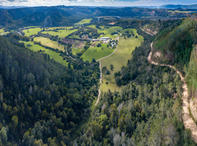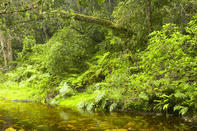Largest Natural Forest Complex in SA
Stretching from Mossel Bay in the west to Harkerville in the east, the indigenous forests of Knysna cover about 45 000 ha of state and private land. Together with the Tsitsikamma forests to the east, this is the largest natural forest complex in South Africa.

Towering forest giants draped with strings of hanging lichens, monkeyrope (Rhoicissus tomentosa), colourful mosses, glades of ferns and tranquil streams create a wonderland inhabited by bright forest birds such as the Knysna lourie (Tauraco corythaix). The indigenous areas are covered with a luxuriant mixture of tall and ancient trees, wonderful fems, creepers and wild flowers.
Animal life, as in most high forests, is limited to a few varieties of forest-dwelling antelope, numerous birds and, until recently, a lingering remnant of the herds of elephant which once frequented the area. Among the 125 species of trees are Outeniqua and real yellowwoods, stinkwood, red and white alders, ironwood, white pear and assegai, while tree ferns and dense undergrowth give the forest a fairy-tale aura.
History of the Forest

From the time Europeans discovered the Knysna forestry area it was ruthlessly exploited. The finest hardwood trees, 600 years old and more, were cut down to provide railway sleepers and timber for ships. It was not only mature trees which were cut, but wagon tracks were blazed to reach them, crushing literally hundreds of young trees in the course of dragging out logs and sawn timber.
An entire community of professional woodcutters derived their livelihood from the Knysna forests. They all firmly believed that the forest was inexhaustible, so they cut at will. Government control came very late. In 1874 Captain Christopher Harrison was appointed conservator, but he had limited control over the tree cutters.
Ten years later a French forester, Comte de Vasselot de Regne, was appointed by the Cape Government to investigate the state of the forests. He found that fully three-quarters of the indigenous forest had been seriously damaged by wanton cutting. He then restricted indiscriminate cutting and divided the forest into sections. The felling was permitted only in specific sections of the forest, while other sections recovered.
Those portions of the forest which had been completely destroyed, as well as other suitable areas, were reafforested. However, demand for timber continued to bring destruction to the forest. In 1913 the Forestry Department introduced fresh control measures by marking trees for destruction and these were allocated to registered woodcutters by means of the drawing of lots. But the number of woodcutters shrunk as the years went by.
In 1932, over the span of 6 years, the number of registered woodcutters decreased by half. In March 1939 the Woodcutters' Annuities Bin passed its final stage in Parliament. The 258 remaining woodcutters were then banned from further private work in the forests and compensated. After the resettlement of the woodcutters, trees for cutting were carefully selected by the Forestry Department and auctioned as they stood to the dealers. The ancient forests of Knysna were then put under the control of the government.
 For holiday-makers in search of the dichotomy of relaxation and adventure can rest assured that accommodation in Knysna on the Garden Route ...
For holiday-makers in search of the dichotomy of relaxation and adventure can rest assured that accommodation in Knysna on the Garden Route ... Knysna lies on the banks of a tranquil lagoon, guarded at its mouth by The Heads and overlooked to the north by the Outeniqua Mountains....
Knysna lies on the banks of a tranquil lagoon, guarded at its mouth by The Heads and overlooked to the north by the Outeniqua Mountains....